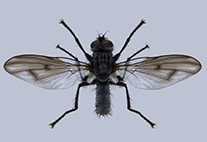Abstract
The extinct São Miguel Scops Owl Otus frutuosoi n. sp. is described from fossil bones found in Gruta de Água de Pau, a volcanic tube in São Miguel Island (Azores Archipelago, North Atlantic Ocean). It is the first extinct bird described from the Azores and, after the Madeiran Scops Owl (O. mauli Rando, Pieper, Alcover & Olson 2012a), the second extinct spe-cies of Strigiformes known in Macaronesia. The forelimb elements of the new taxon are shorter, the hindlimb elements are longer, and the pelvis is shorter and broader than in the Eurasian Scops Owl (O. scops Linnaeus). The new species differs from O. mauli in the smaller size of many of its bones, especially the ulna and tibiotarsus. Its measurements (esti-mated weight, wing area, and wing loading, and the ratio of humerus + ulna + carpometacarpus length/femur length) in-dicate weak powers of flight and ground–dwelling habits. The latest occurrence of the new species, as evidenced by a radiocarbon date of 1970±40 BP from bone collagen, indicates a Late Holocene extinction event subsequent to 49 cal BC, and was probably linked to human arrival and subsequent habitat alterations

